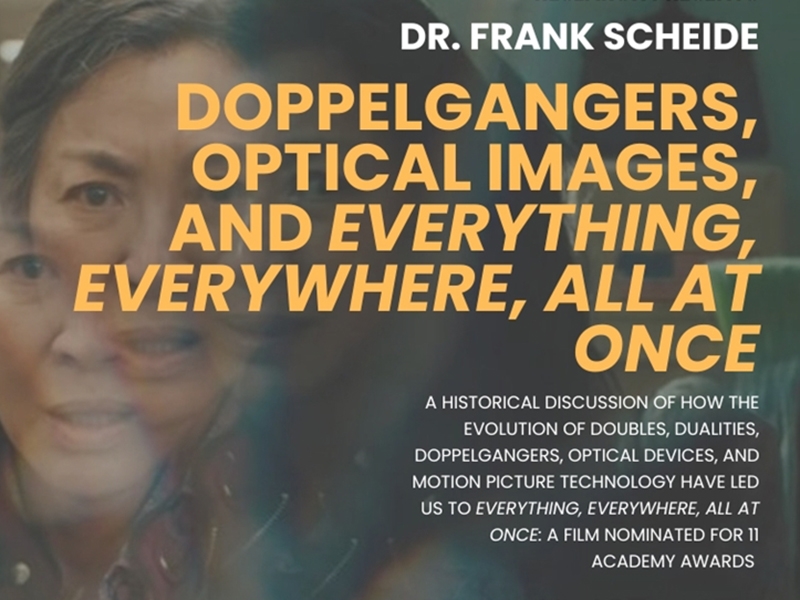
The Center for Communication Research is hosting a colloquium featuring acclaimed film professor Dr. Frank Scheide and his presentation on "Doppelgangers, Optical Images, and Everything, Everywhere, All at Once" from 3-4 p.m. Friday, March 10, in Kimpel 407.
Since the time the Greek demi-god Narcissus peered into a pool and was both confused and enamored with what he saw, humans have fixated upon self-reflection. How did we get from Narcissus staring into a pond to the exploration of multifaceted identity in the Academy Award-nominated Everything, Everywhere, All at Once?
Throughout the centuries, the evolving technology that has been invented and developed so we can better understand the object of our self-perception has also been fostering fears relating to the dangers of what we will learn. Leonardo da Vinci's optical studies in the late 1400s resulted in refinements of the camera obscura that revolutionized the art of the Renaissance. His sketchbooks contain drawings for a projector that later would be called the "magic lantern" following its invention in the 1600s. Used by well-meaning teachers to educate illiterate populations, the magic lantern was also employed by charlatans to terrify people into believing the ethereal projections they were experiencing were actual ghosts and ghostly doubles. As we can see whenever we attend a lecture today, the magic lantern and the fears it generates are still with us today.
"Doppelgangers, Optical Images, and Everything, Everywhere, All at Once" is a historical review of how the evolution of doubles, dualities, doppelgangers, optical devices and motion picture technology over the centuries have led us to Everything, Everywhere, All at Once, a film nominated for 11 Academy Awards.
Scheide is a professor in the Department of Communication at the U of A, where he teaches film history and criticism. His doctoral dissertation focused on Charlie Chaplin's music hall career. Scheide wrote the textbook Introductory Film Criticism: A Historical Perspective (1994). He co-edited Chaplin: The Dictator and the Tramp (2004) and Chaplin's Limelight and the Music Hall Tradition (2006). While cataloging the British Film Institute's collection of Chaplin outtakes in 1999, he discovered footage shot for Sydney Chaplin's lost 1921 feature, King, Queen, Joker, which he discovered was a prototype for his brother Charlie's 1940 classic, The Great Dictator. Scheide is currently writing a book about the history and restoration of King, Queen, Joker and its influence on Charles Chaplin's employment of the doppelganger as a social corrective in political narrative.
Scheide co-founded the U of A Native American Symposium in 1995, co-founded the U of A's Indigenous People's Day annual observance in 2004, founded the U of A's annual Silent Native American Film Series in 2005 and established the "Dave and Jimmie Lou Whitekiller Indigenous American Video Collection" in 2018, which consists of several hundred one-of-a-kind videos shot by U of A faculty and students from 1984 to the present, with support from the Center for Communication Research.
Topics
Contacts
Lacie Bryles, marketing and programs specialist
Department of Communication
479-575-7237, lcarte@uark.edu